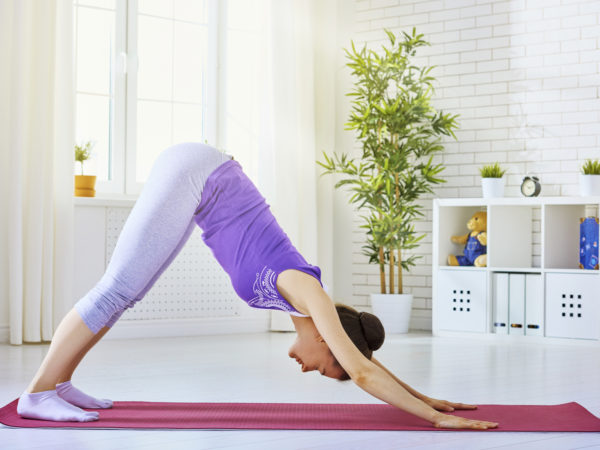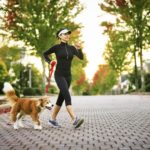Downward-Facing Dog

“Practicing the Downward-Facing Dog really helps me stretch out the muscles of my legs. It’s a wonderful way to enter a deeply relaxed state after a long day.” – Andrew Weil, M.D.
Description & History
Downward-Facing Dog is a popular yoga pose for stretching the muscles of the legs and shoulders. The Sanskrit name, Adho Mukha Svanasana, comes from the words adho meaning downward, mukha meaning face and asana meaning posture.
Downward-Facing Dog is commonly used as a rest pose between difficult poses. It is important to maintain focus while performing this pose to experience the maximum benefit.
How to Perform Downward-Facing Dog
- Begin by resting your hands and knees on the floor with your toes curled. Set your knees directly below your hips and place your hands slightly forward of your shoulders.
- Exhale and push your knees away from the floor, raising your hips and straightening your legs. Keep your arms straight and hands firmly on the floor. Rotate the shoulder blades out away from your head. Let the head hang in line with the arms with eyes looking up at the navel keeping the neck free from extension.
- Keep the tailbone pointed to the sky. The body should look like an inverted “V” from the side.
- Hold the Downward-Facing Dog pose for 30 seconds to two minutes. Pay careful attention to your shoulders and wrists and stop if you feel any pain.
- To release from Downward-Facing Dog, exhale and slowly drop your knees to the floor and come to a rest with your arms under your shoulders as in Child’s Pose.
Watch a video demonstration of Downward-Facing Dog.
Potential Health Benefits
- Improves the immune system, digestion and blood flow
- Calms the mind and relieves stress
- Helps relieve mild depression
- Stretches and strengthens the shoulders, arms, legs and back
- Helps prevent osteoporosis
- Relieves menstrual discomfort
A study review published in a 2012 edition of Frontiers in Psychiatry looked at effective treatments for mental illness. The study stated there is support for yoga in treating depression and sleep disorders. While no study has proved the effectiveness of Downward-Facing Dog for any particular condition, practitioners have reported increased mental acuity from the pose.
Modifications & Variations
Many first-time practitioners of the Downward Facing Dog are unable to straighten the legs and make the body into an inverted “V” from the side. For beginners, dropping the knees slightly while keeping the arms straight is a common adjustment until the legs become more flexible.
Beginners can also modify the pose: starting from a standing position, bend at the waist and rest the arms on a chair against a wall or some other secure structure to achieve the same results. This modified pose is also beneficial as it can greatly reduce stress on the shoulders, elbows and hands if the practitioner experiences pain.
There are a few advanced modifications of the Downward-Facing Dog that can deepen the pose and provide additional stretching. One modification is to enter into the pose and use the calf muscles to lift up onto the balls of the feet and drop your forearms to the floor and rest on them. This movement should increase the stretch of the leg muscles. Another modification is to widen the starting position of the feet and following the same movement as the original pose. A third modification is to lift one leg so it is in line with the arms and torso while in the Downward-Facing Dog and then switch legs after 30 seconds. These advanced modifications can increase the chance of pain and injury, so pay careful attention to any discomfort you may feel.
Precautions
Downward-Facing Dog places great stress on the shoulders and wrists. Use caution if you currently have or have experienced the following:
- Diarrhea
- Carpal tunnel syndrome
- Hypertension (high blood pressure)
- Pregnancy (especially late-term)
The Downward-Facing Dog can cause you to feel lightheaded and dizzy. It is important that you do not stay in this pose for an extended period of time, especially if you have hypertension or are sensitive to headaches. You can use a bolster or block to support your head at ear level between the arms.
Related Poses
- Standing Forward Bend Pose (Uttanasana)
- Intense Side Stretch Pose (Parsvottanasana)
- Seated Forward Bend Pose (Paschimottanasana)
Reviewed by: James Nicolai, M.D., on May 20, 2013
Sources
Balasubramaniam, Meera, Shirley Telles, and P. Murali Doraiswamy. “Yoga on our minds: a systematic review of yoga for neuropsychiatric disorders.” Frontiers in Psychiatry 3 (2012).









